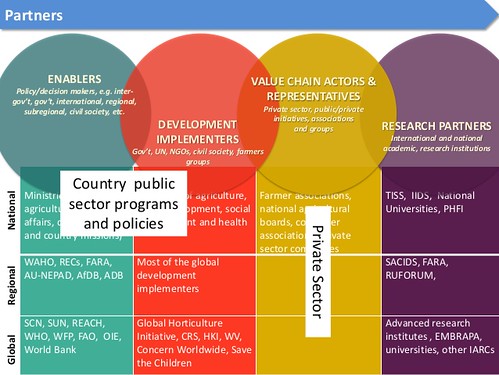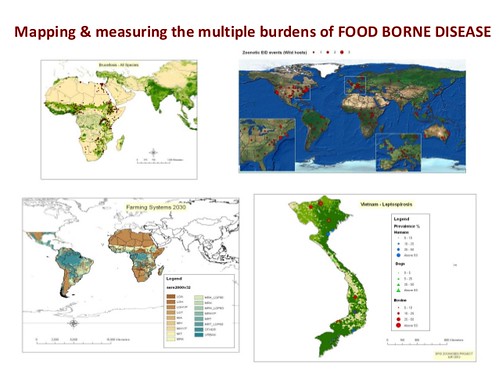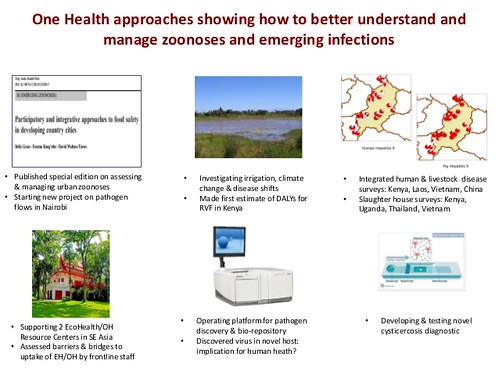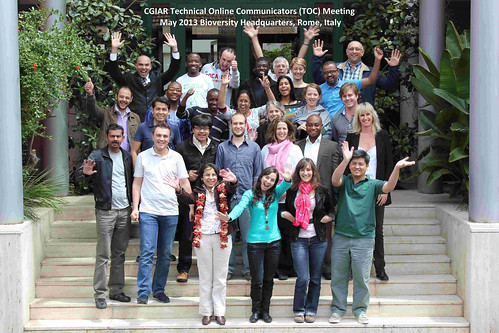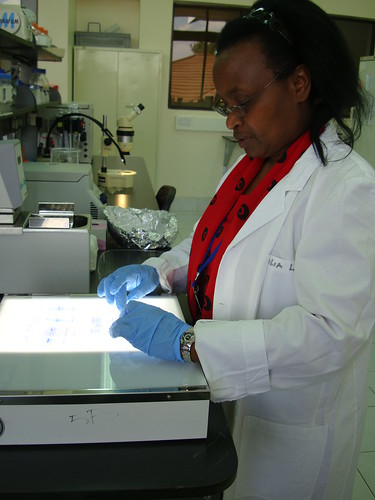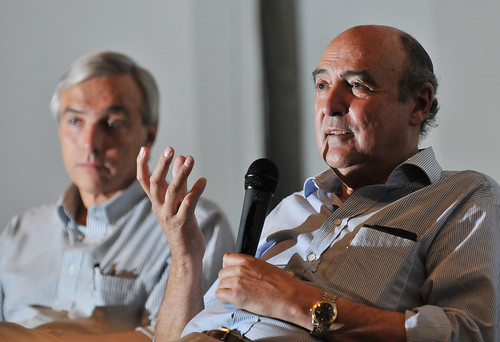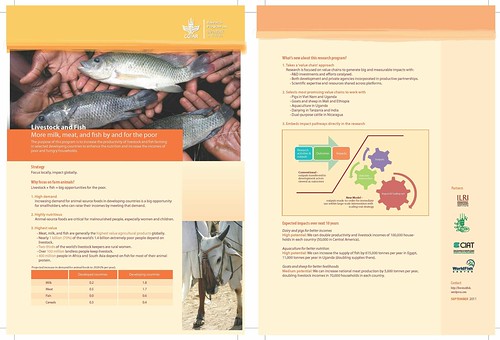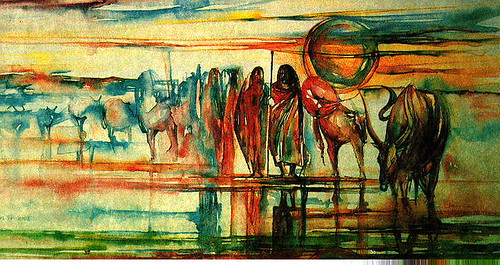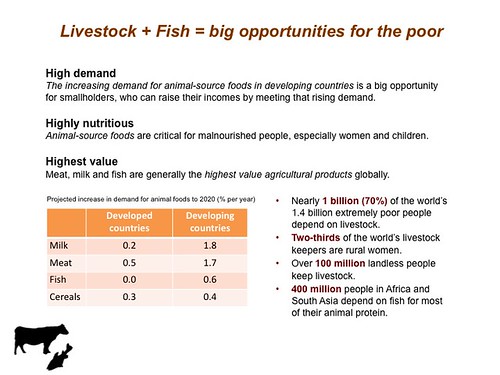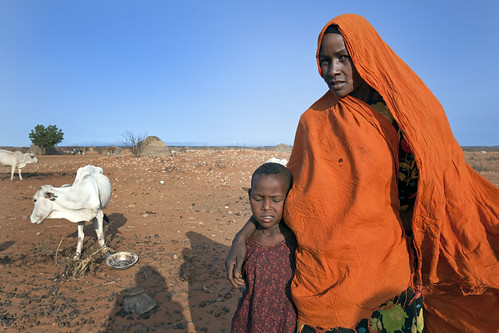
Ethiopian pastoralists of Somali origin have been trying to sustain their livestock livelihoods after some of their land was used to build a camp for Somali refugees at Dolo Ado, Ethiopia (photo on Flickr by Petterik Wiggers/Hollandse Hoogte—Photostream Giro 555 SHO).
The Africa Union’s Interafrican Bureau for Animal Resources (AU-IBAR) recently convened a two-day consultation of experts working to address the challenges to development of the arid and semi-arid lands of the Horn of Africa. This expert consultation on ‘Interventions for sustainable livestock systems in the Horn of Africa,’ was held 2–3 Sep 2011 at the International Livestock Research Institute’s headquarters, in Nairobi, Kenya. The AU meeting was preceded by a news briefing and learning event convened by the CGIAR Consortium of International Agricultural Research Centers. CGIAR CEO Lloyd Le Page participated in both the Consortium and AU drought-related meetings.
Both meetings helped to identify opportunities for sustaining food production in this sub-region, which continues to suffer from the catastrophic impacts of a severe drought, and helped to develop an initial framework for making better use of those agricultural opportunities in future.
The more than 40 experts gathered at the AU meeting developed a joint statement to better inform long-term development of this region’s drylands. This statement, which follows in full, will be used at upcoming high-level meetings on topics related to food security.
Expert Consultation to inform long-term development of arid and semi-arid lands in the Greater Horn of Africa
2–3 September 2011
A Joint Statement
Preamble
The current food security crisis in the Greater Horn of Africa is a stark reminder that insufficient attention has been given to addressing the root causes of vulnerability in the arid and semi-arid lands (ASALs) of this region. It is also apparent that it is not drought but rather vulnerability during drought in the ASALs that has thrown the region into repeated food crises. Yet in contrast to this vulnerability is the fact that the ASALs produce most of the livestock traded in the region, contributing up to 50% of agricultural GDP to the national economies, in addition to playing wider economic roles. African leaders at the country, regional and continental levels, along with global leaders and the development community, are now confronted with, and attempting to address, the questions: why do we continue to regard what is so clearly an asset as a liability; and what would an appropriate long-term development program look like that could sustainably harness the productive potential of the ASALs and reduce repeated crises?
In the next several months, numerous technical and political consultations are planned to discuss short, medium and long-term development in the ASALs. Against this backdrop, and the urgency of tackling this challenge head on, the African Union (AU) through its Interafrican Bureau for Animal Resources (AU-IBAR) convened an expert consultation 2–3 September 2011 in Nairobi, which was hosted by the International Livestock Research Institute (ILRI), a center of the CGIAR Consortium.
The consultation brought together over 50 development practitioners, researchers, and policy makers (from non-governmental organizations, government, regional organizations, international research institutes, and development agencies) from the Greater Horn of Africa and globally that are or have been engaged in addressing the challenges to the development of the ASALs.
This statement is a summary of key trends identified and recommendations of the experts. It also provides a summary of outcomes, illustrative interventions and issues for consideration.
Context and Trends
Context
- ASALs account for 70% of the land area of the countries in the Greater Horn of Africa.
- ASALs are a discrete geographic area in the Greater Horn of Africa where the population is vulnerable.
- The shared agro-ecosystem, including natural resources such as water and pastures and common production systems, offers an opportunity for cooperation among countries to identify and implement solutions.
- Pastoral and agro-pastoral livestock production systems are the primary economic enterprise and main economic driver in the ASALs.
- There are now a large number of activities being implemented at country and local levels to help mitigate the impacts of drought and to build household and community resilience in an environment of increasingly unpredictable rainfall.
- Social, technical and economic services are not widely available, especially to the mobile pastoral populations, and the longer-term development needs of the ASALs are generally neglected.
- Insecurity in the region exacerbates vulnerability and hinders effective response and other interventions.
Important trends
- The region is experiencing an increased number of shocks, especially more frequent droughts and floods, but also man-made shocks.
- Although the long-term impacts of climate change cannot yet be accurately predicted, there appears to be increased variability of rainfall; and although many experts believe the region will become progressively hotter and drier, some parts may become wetter and more flood-prone.
- There are growing opportunities for international/regional trade in livestock products due, in large part, to the increased demand for these products in Africa and the Middle East fuelled by growing populations, urbanization and rising incomes.
- While access to services remains generally poor in the ASALs, significant progress has been made recently through greater access to, and coverage by, mobile phones.
- Country strategies and investment plans are in place, but ASAL programming, although it is included, is not prioritized, coordinated or well developed.
- Ongoing processes of land fragmentation, insecure tenure and use rights, and externally driven land appropriation processes also undermine pastoral productivity.
- Improved research coordination and frameworks are already in place[1] but need to be leveraged to support the ASALs.
- Policy windows of opportunity are emerging nationally and regionally, and the political voice of pastoralists is increasing.
Strategic Actions and Recommendations
The immediate challenges being faced in the Greater Horn of Africa serve as a call to action that is being heard and responded to by many countries, agencies, and interest groups. The immediate attention to saving lives and protecting livelihoods is indeed critical. However, much of this response, especially the efforts focused on long-term development, could make better use of existing systems, evidence and best practices to inform investment. They are too often partial solutions because no single country or agency has the ability to mobilize the resources or political will to operate at the scale needed to systemically tackle the issues. Recognizing the need for coordinated action, two recommendations are summarized below to advance a more effective mobilization of domestic resources and foreign development assistance in support of a long-term development effort.
1. The African Union should establish a task force to assist countries and regional economic communities (RECs) to design and mobilize support for long-term development of the ASALs in the Greater Horn of Africa. The fundamental task is to translate national strategies and investment plans for agriculture and food security that now exist into concrete activities and services. This will require:
- Analysis to help inform and clarify the expected outcomes and targets from the investment in ASALs on the national agriculture and food security goals and targets, articulated through their CAADP Plans.
- An inventory and review of ongoing efforts in the ASALs, identify best practices and modalities or instruments to consolidate ongoing efforts, align them with long term goals and targets, and scale up the best practices.
- Strategic coordination of research and technical support to assist national coalitions of government, development partners, NGOs and the private sector to prioritize various interventions for the ASALs.
- Development of partnerships to support and implement high-priority policy recommendations, and research, development and economic growth projects and activities.
- The review of options for establishing an implementation framework at the national and regional levels that provides effective coordination, and that clarifies the roles and responsibilities of various parties in the implementation of a coordinated investment strategy for ASALs.
- The task force is envisaged as a temporary measure with a lifespan of around 6 months: an important task during this period will be to identify a more sustainable platform to provide ongoing effective coordination to support long-term development of the ASALs of the Greater Horn of Africa.
2. The international community and bilateral development agencies should mobilize a consortium of technical organizations, e.g. CGIAR, FAO, WFP and NGO partners (e.g. REGLAP) to work with and support the AU task force in close consultation with the concerned countries to identify best practice, develop programs, provide technical services and conduct relevant research to support long term development of the ASALs.
Illustrative Outcomes and Interventions for Long-Term Development of ASALs
The expert consultation identified key challenges that a long-term development effort in the ASALs will face, considered major outcomes that will need to be pursued, and began to examine best practices that have been developed and are being applied, typically on a small-scale basis, that could be helpful in the long-term development of the ASALs. The expert consultation considered possible outcomes and actions for long-term agenda from the lens of: a) increasing the contribution of the ASALs to agricultural growth and national development goals and targets; and b) diversifying livelihoods and improving resilience amongst vulnerable households in ASAL areas of the Greater Horn of Africa.
Six major outcome areas and related illustrative interventions are considered as key in advancing the long-term development of the ASALs. They include the following.
Make national and regional pastoral policy frameworks operational
- Define and elaborate ASAL programmes within the umbrella of the CAADP investment plans that are consistent with the AU policy framework for pastoralism and other regional initiatives, such as the IGAD regional policy framework on animal health in the context of trade and vulnerability
- Promote regionally harmonized policy on livestock trade and the movement of livestock and people
- Capacity strengthening of RECs, national and local agencies coordinating and implementing ASAL development where and as appropriate and requested
- Effective monitoring and evaluation of policy implementation
Sustainable ecosystem management
- Integrate local knowledge through participatory action research so as to ensure that strategies fit with local perspectives and priorities
- CGIAR mentoring of national agricultural research services in applied research in ecosystem dynamics
- Develop payment systems for environmental services that benefit pastoralists
- Facilitate carbon sequestration and methane emission reduction
- Enhance the use of natural resource (e.g. improved land-use planning; and water and soil management efforts.)
Secure regional trade
- Inter-regional financial systems
- Product standardization linked to SPS measures
- Enhanced negotiation capacity
- Reduced non-tariff trade barriers
- Niche market development
- Improved road, market, water and communication infrastructure
Institutionalized disaster-risk management and response
- Assess need for early-warning systems for different stakeholders
- Develop demand-driven knowledge products
- Improve dissemination of early-warning information using alternative media
- Invest in data management systems
- Establish functional mechanisms for early response
- Fund early response, especially at local levels, within a conducive policy and institutional setting
- Provide safety nets
- Provide index-based livestock insurance
- Enhance traditional coping strategies
Empowered pastoralist communities
- Strengthened producer associations
- Conflict resolution – grazing, land access, environment
- Strengthened traditional NRM strategies
- Increased awareness of improved coping measures, such as timely destocking
- Increased community participation in policy decisions and resource allocations
- Capacity development for community driven development in government and at community level
- Vocational training in technical and business skills
- Social fund for cost-shared community-driven investments
Improved and alternative incomes
- Effective community-based animal health services
- Effective veterinary epidemiology program
- Competitive private input supply
- Secure access to land and water
- Development of irrigation
- Dryland products such as resins and gum arabica
- Savings-driven credit schemes
- Information-technology-based market information
- Vocational training in technical and business skills
- Basic numeracy and literacy
- Energy and environmental services
Next Steps for Catalyzing Action
Recognizing the urgency of the situation, it is proposed that the African Union convenes a broadly based task force immediately, drawing on the rich expertise available within the region, continent and globally.
At the same time this joint statement should be distributed to other stakeholders, including the donor community, engaged in technical and political consultations over the next few weeks and months, with a view to mobilizing a coordinated effort to shape and implement a long-term development program to tackle the underlying causes of vulnerability in the ASALs of the Greater Horn of Africa.
[1] Newly approved CGIAR Research Programs, in partnership with national research institutes and other stakeholders, have the capacity to identify information and knowledge gaps, and provide research and innovation fundamental to the ASALs finding lasting and viable solutions, and to provide improved food security, reduced poverty, enhance nutrition and health, and more sustainable use of natural resources for the Greater Horn of Africa region.
Read more about these meetings on the AU-IBAR website and on the ILRI News Blog:
‘Africa’s drylands are productive, and potentially very productive’–ILRI’s Bruce Scott
CGIAR media briefing on the food crisis in the Horn of Africa: A strengthened and joined-up approach is needed
CGIAR briefing on the food crisis in the Horn of Africa: 1 September at ILRI Nairobi
Investments in pastoralism offer best hope for combating droughts in East Africa’s drylands–Study


